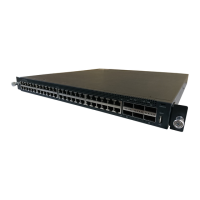User’s Guide FUJITSU PSWITCH
December/2018 59
3.1.2.5.6. Preboot Execution Environment support
The switch allows the LAG fallback to a single port active while the LAG without
receiving LACP PDUs in the timeout period. This feature can provide to switch
connection to a connected device and establish a connection to PXE boot download
image and booting process. When booting process of a connected device
completes, it may fully formed an LACP Port-Channel.
In other case, the switch LAG form success, but part member port form failure these
port state is “Block”.
Preboot execution environment (PXE) limitations
LAG must be “Dynamic” mode -
LAG member port must be “Disable” STP mode, but LAG interface doesn’t care. -
LAG must be not VPC interface and VPC peer-link -
3.1.2.6. VPC (Virtual Port Channel) or Multi Chassis LAG
Like standard LAGs, virtual port channels (VPCs) allow one or more Ethernet links
to be aggregated together to increase speed and provide redundancy. VPCs are
also known as multi-chassis or multi-switch link aggregation groups (MLAGs). With
standard LAGs, the aggregated links must be on the same physical device, but VPCs
do not share that requirement. The VPC feature allows links on two different
switches to pair with links on a partner device. The partner device is unaware that
it is pairing with two different devices to form a port channel.
Figure 3-1: VPC Topology
The components in the figure – VPC Topology are as follows:

